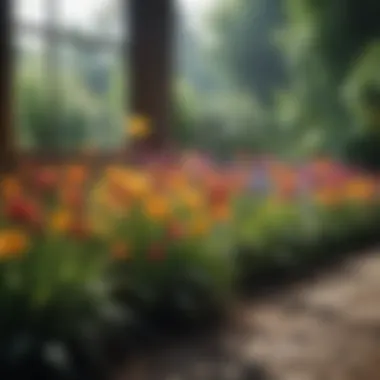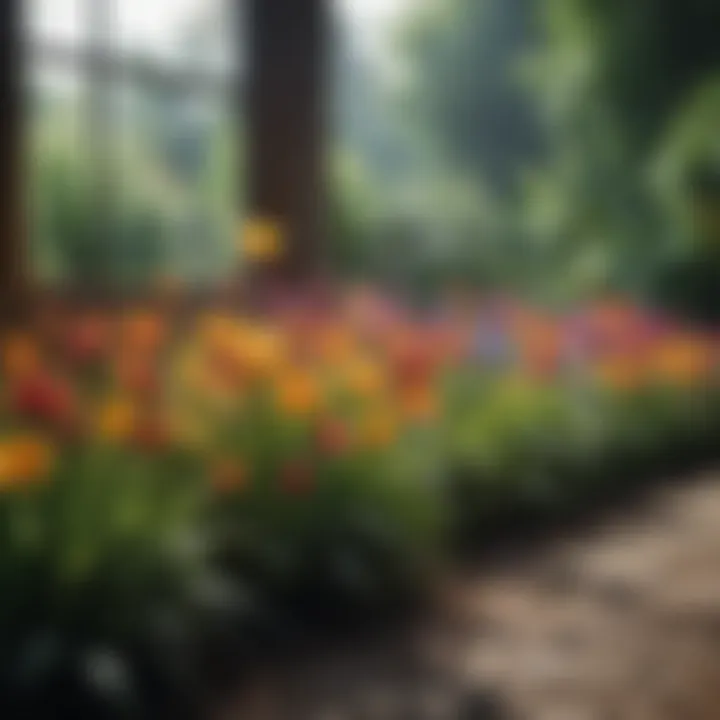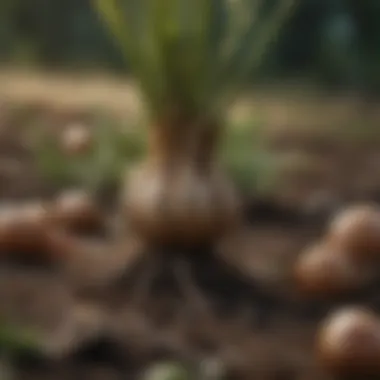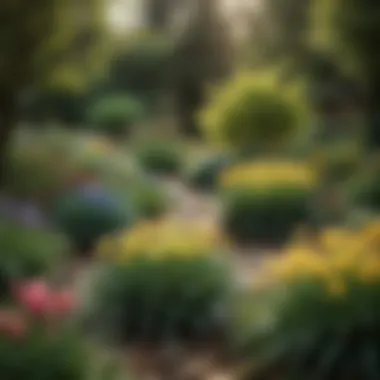Cultivating Beauty: Late Summer Bulbs Guide


Intro
Embarking on the journey of gardening brings with it the promise of color, vibrancy, and a touch of nature's wonder. Late summer bulbs play a significant role in this narrative. They serve not only as floral delights that brighten up the garden but also as strategic choices for extending the bloom season.
Understanding the importance of these bulbs comes with an appreciation for their various types and how they can enhance garden aesthetics. By carefully selecting late summer bulbs, gardeners can ensure that their landscapes remain lively even as other flowering plants start to fade after the warm weather peaks.
In this guide, we delve into essential aspects of late summer bulbs, including useful planting techniques and care guidelines, while navigating the common challenges that may arise during cultivation. With this information in hand, both novice and seasoned gardeners can cultivate beauty that lasts well into the autumn months.
Design Inspirations
Trending Styles
When designing a garden that incorporates late summer bulbs, consider current trends that resonate with your personal style. Cottage gardens have made a comeback, inviting an earthy and romantic aesthetic with a mix of colors and plant types. Varieties such as gladiolus and dahlias fit beautifully into this style, giving the garden a charming and unstructured feel.
Alternatively, modern minimalist designs focus on clean lines and fewer color distractions. Pairing varieties like Allium with ornamental grasses can create a striking contrast, emphasizing each bloom's unique shape.
Color Palettes
Choosing the right color palette is crucial when working with late summer bulbs. Consider these combinations:
- Warm tones: Reds, oranges, and yellows evoke energy and enthusiasm, perfect for a welcoming front garden.
- Cool tones: Blues, lavenders, and whites inspire tranquility and work well in shaded areas.
- Contrasting hues: Making bold statements with contrasting colors like deep purples against bright yellows can create visual interest that lasts until fall.
When selecting colors, consider the surrounding landscape. Choosing complementary colors with trees or fences can unify the garden aesthetic.
Maintenance and Upkeep
Seasonal Maintenance Checklist
To ensure the longevity and health of late summer bulbs, a seasonal maintenance checklist is vital. Here are some key tasks to consider:
- Early spring: Check soil drainage and amend as needed.
- Mid-summer: Water regularly, especially during dry spells, to promote strong blooms.
- Post-bloom: Deadhead spent flowers to encourage more budding and prepare plants for dormancy.
Cleaning and Organization Tips
A tidy garden is a happy garden. Keeping your late summer bulbs organized and clean can enhance their beauty. Regularly remove weeds to reduce competition for nutrients and moisture. It helps to have clearly defined rows for easier maintenance. Consider marking each variety with simple labels so they can be easily identified later. This practice not only makes care easier but creates a more intentional design throughout your space.
"Beauty is in the details. Care for your garden as you would for a masterpiece."
By nurturing your garden with attention to detail, thoughtful design choices, and a proactive approach to maintenance, your late summer bulbs can flourish, offering bursts of color and life long into the later months of the year.
Understanding Late Summer Bulbs
In the world of horticulture, late summer bulbs emerge as the unsung heroes, extending the blossoming lifeline of gardens during a season often disregarded. These bulbs hold the promise of lush colors and vibrant visuals when many flowers have already faded into a quiet slumber. Understanding late summer bulbs isn’t just about knowing what to plant; it's about appreciating their role in creating a flourishing ecosystem right when it seems like nature is winding down.
Definition and Characteristics
Late summer bulbs are geophytes, meaning they store nutrients in underground organs, typically bulbs, corms, or tubers. This adaptation allows them to thrive in varying conditions, ensuring beauty even as the warmer days begin to wane. Examples include:
- Gladiolus, with its tall spikes and vibrant hues.
- Dahlias, celebrated for their unique flower forms, offering an extensive palette.
- Calla lilies, with elegant blooms adding sophistication.
These bulbs are generally planted in late spring or early summer, depending on the climate, and they bloom through late summer into early autumn. Their striking colors and diverse shapes not only enhance aesthetic value but also serve as critical components in attracting pollinators, making them vital players in any garden composition.
The Role of Late Summer Bulbs in Gardening
The inclusion of late summer bulbs in gardens brings multiple benefits. Initially, they extend the flowering period, which can be particularly appealing for homeowners wanting to prolong the visual interest of their outdoor space. When gardens begin to lose their vibrancy, these flowers step in to fill the gaps. They also provide a layer of seasonally appropriate color combinations that can complement earlier spring and summer designs.
Adding late summer bulbs can be a strategic move from a design perspective. When planted among perennials that bloom earlier, the transition becomes seamless, with bulbs acting as a natural bridge in the blooming calendar. Moreover, they require relatively simple care once established, making them accessible options even for novice gardeners.
"Late summer bulbs can truly transform a lackluster garden into a kaleidoscope of colors when combined thoughtfully with existing plants."
Additionally, these bulbs contribute to soil health and provide a habitat for various beneficial insects. The height and structure of certain varieties can even act as windbreaks or natural supports for smaller plants. All in all, embracing late summer bulbs is like inviting extra guests to a gathering who know how to liven up the party. Armed with the right knowledge, gardeners can create a sustainable and visually stunning outdoor environment.


Key Varieties of Late Summer Bulbs
When we talk about late summer bulbs, it’s not just about filling the garden with color. Understanding the key varieties gives gardeners tools to extend beauty through changing seasons and environments. Each bulb type offers its unique flare, making them an asset to any backyard or landscaped area.
Popular Choices for the Season
Gladiolus
Gladiolus, often called the sword lily, stands tall and proud with its flower spikes that can reach impressive heights. This plant is known for its vibrant colors and varying heights, making it a popular choice. Its unique feature lies in its long-lasting blooms, which can be cut for arrangements, meaning it’s a favorite among flower enthusiasts and event planners alike.
The benefit of choosing Gladiolus is notable: they bring vertical interest to a garden bed, breaking up low-growing plants and providing a stunning backdrop. However, they require staking to prevent them from flopping over in heavy winds or rain, which can be a drawback in exposed areas.
Dahlia
Dahlia bulbs are another gem in the summer garden arsenal. Known for their lush, bushy form and an astonishing variety of colors and shapes, these flowers are fantastic for both casual and more formal spaces. Often sought after for their dramatic presence, dahlias provide a range of textures that appeal to the eye.
What makes dahlias particularly interesting is their bloom time, which can last well into fall if cared for properly. But they tend to require more maintenance compared to other varieties. You’ll want to be vigilant about pests and diseases, as they can be quite sensitive to their surroundings.
Tuberous Begonias
With their graceful petals and understated elegance, Tuberous Begonias add a softness to any arrangement or garden bed. These bulbs are typically favored for their shade tolerance, making them perfect for spots where sunlight is at a premium. Their thick, succulent leaves create a lush backdrop for their gorgeous blooms.
A unique feature of Tuberous Begonias is their ability to thrive under varying conditions, making them versatile for garden design. One downside is their sensitivity to frost, which requires gardeners to either move them indoors or ensure that they are in a protected location during colder months.
Calla Lilies
Calla Lilies are synonymous with elegance, recognized for their sleek, trumpet-shaped blooms and their strikingly upright stature. These flowers are often the choice for formal gardens and even weddings due to their sophisticated look. The unique feature of Calla Lilies involves their association with themes of purity and rebirth, further enhancing their desirability.
However, they do require a bit of moisture and can be prone to rot if over-watered, a common pitfall for less experienced gardeners. Overall, Calla Lilies make a striking addition with the right care.
Emerging Trends in Bulb Selection
As gardening evolves, so do the preferences for specific bulbs. Environmental sustainability is at the forefront of many gardeners' minds today, pushing people to consider native species and those that benefit local ecosystems. Additionally, many enthusiasts are now opting for mixed plantings that combine late summer bulbs with perennials and annuals. This not only enhances aesthetics but supports the biodiversity that is crucial for thriving gardens.
Planting Late Summer Bulbs
Planting late summer bulbs isn’t just a process; it’s like setting the stage for a vibrant, natural spectacle that unfolds in your garden. These bulbs are crucial not only for their beauty but for their role in prolonging the blooming season. When you understand how to plant them correctly, you set the groundwork for flourishing flowers that can turn any garden into a lively tapestry of colors. Their fragrant blooms can attract pollinators, and they add a splash of vibrance to your spaces as the summer sun begins to fade.
Ideal Planting Conditions
To achieve the lush growth associated with late summer bulbs, it’s vital to understand the ideal planting conditions. These bulbs thrive in settings with well-drained soil, ideally sandy or loamy. The soil should have a pH level between 6 and 7, as this range enhances nutrient availability. Sunlight is another key player; most late summer bulbs prefer a sunny spot where they can soak up six hours or more of direct light daily.
Additionally, protection from strong winds is beneficial because certain varieties can be top-heavy. It can also help to choose a location with some degree of shelter, like next to a wall or in a corner of the garden, to help safeguard them from harsh weather.
Step-by-Step Planting Guide
Preparing the Soil
Preparing the soil is one of the most significant steps in ensuring healthy growth for late summer bulbs. Start by clearing out weeds and debris, which can compete for nutrients. Loosening the soil allows for proper aeration and drainage, essential for preventing rot. A key characteristic of well-prepared soil is its consistency—you want it crumbly and moist but not overly wet.
Adding organic matter like compost not only enriches the soil but also improves its structure. This is a beneficial choice as rich soil can better hold moisture while still draining well. Remember, preparation can make or break your gardening efforts; if you neglect this step, your bulbs might struggle to take root.
Depth and Spacing Considerations
Depth and spacing are critical aspects when planting late summer bulbs. Generally, bulbs should be planted at a depth that’s about three times their height. This ensures adequate warmth and protection from environmental factors. As for spacing, each bulb should have room to breathe—about six to twelve inches apart, depending on the variety.
This consideration is beneficial as it prevents overcrowding and allows for ample air circulation. Bulbs planted too close together can compete for nutrients and may lead to poor growth. A unique feature of depth and spacing is their impact on flowering; properly spaced bulbs tend to showcase their colors with more prominence, creating a stunning display.
Watering Techniques
Watering techniques significantly influence the success of your late summer bulbs. Initially, watering immediately after planting is crucial to help settle the soil around the bulbs. However, after the initial watering, it’s essential to avoid over-watering. Bulbs prefer their soil to dry out slightly between waterings. This prevents rot and ensures their health.


A key characteristic of effective watering is to soak the soil deeply rather than giving it a light sprinkle repeatedly. This promotes stronger root development as the plants reach down into the soil for moisture. An occasional check with your finger can help gauge the moisture level; if it’s dry an inch below the surface, it’s time for a drink.
With these elements in mind, the process of planting late summer bulbs becomes not just an endeavor, but an art form that allows gardeners to sculpt living beauty in their spaces.
"Understanding the nuances of planting bulbs can be the difference between a mediocre garden and an awe-inspiring floral wonderland."
By carefully tending to these planting principles, your garden can flourish with rich colors and fragrant blooms through the late summer months.
Care and Maintenance of Late Summer Bulbs
Caring for late summer bulbs is akin to a continuous dance, requiring attentiveness and grace. Just as a gardener’s touch can coax blooms from the earth, proper maintenance ensures that your bulbs thrive, offering a vibrant display while prolonging the growing season. Between watering, pest management, and supporting their growth, these practices serve to optimize the health and beauty of your garden throughout the late summer months. Understanding these elements can be the difference between a flourishing garden and a lackluster one.
Watering and Fertilizing
Watering is essential for late summer bulbs, and it is important to establish a routine that matches their needs. Generally, they prefer well-draining soil that doesn’t stay soggy; overwatering can lead to rot, a serious threat to their vitality. During dry spells, a consistent schedule, watering deeply once a week can help the bulb establish a healthy root system.
Fertilizing is also crucial. A balanced fertilizer applied at planting time and again mid-summer can provide necessary nutrients for blooming. Long-lasting effects are gained from slow-release fertilizers, ensuring the plants receive what they need without the risk of burning their tender roots.
Pest and Disease Management
Identifying Common Pests
In the world of gardening, an attentive eye can catch potential problems before they run rampant. Common pests that take a liking to late summer bulbs include aphids, spider mites, and lily beetles. Each poses a unique threat, nibbling away at foliage or blooms.
For instance, aphids can form large colonies, sucking sap from the leaves and weakening the plant, whereas spider mites leave a characteristic yellowing and a fine webbing. Catching these nuisances early on—like noticing a flicker of movement on the undersides of leaves—can spare your garden from significant damage.
These pests may seem small, but their impact can be monumental, showcasing why understanding their behavior is key to maintaining your floral arrangements.
Preventive Measures
Preventive measures are the best defense against pests. For instance, introducing beneficial insects such as ladybugs can naturally decrease pest populations. Additionally, a keen observation of plant health and regular inspections can help uncover issues before they escalate. This proactive approach is beneficial, keeping the delicate balance within the garden ecosystem intact.
Another measure is applying organic insecticides early in the season. This step can inhibit pest populations while being gentler on the environment compared to synthetic options. Not all solutions are created equal; some could harm beneficial organisms. Researching and selecting the right method can enhance your approach to pest control.
Supporting Growth and Longevity
To support the ongoing growth and longevity of late summer bulbs, proper spacing and staking are keys to success. Crowding can lead to competition for resources, stunting their growth. A general rule of thumb is to space bulbs according to their variety and ultimate size.
Also, as the plants grow taller, staking may be necessary to prevent flopping, especially in windy conditions. Bamboo stakes or decorative supports can do the trick without clashing with the aesthetic of the garden.
"A well-tended bulb garden can produce a stunning spectacle that draws the eye and lifts the spirit, proving that with dedication, beauty can bloom even late in the season."
By combining careful watering, vigilant pest management, and supporting healthy growth, gardeners can ensure their late summer bulbs reach their full potential. Each bulb planted is a promise of color and life, making these care practices truly worthwhile.
Designing with Late Summer Bulbs
Designing with late summer bulbs offers more than just a splash of color; it’s about creating a vibrant tapestry that enhances the overall aesthetic of your garden. These bulbs not only prolong the blooming season, but they also provide numerous benefits that should not be overlooked. When it comes to selecting which bulbs to plant, consider factors like height, color, and flowering duration to craft an engaging visual story from spring through to autumn. This section dives into dimensions such as color schemes, which can be the backbone of your design, and incorporating bulbs into established gardens, ensuring a seamless blend of beauty and function.
Color Schemes and Combinations
Using late summer bulbs enables you to play with a multitude of color palettes. The right combination can create strength and drama in your garden.
- Contrasting Colors: Use colors that are opposite on the color wheel, such as deep purples paired with bright yellows. This will catch the eye and add vibrancy to the landscape.
- Analogous Colors: For a more harmonious look, select bulbs that are next to each other on the color wheel. Lavender shades mixed with light blues can evoke calmness and peace.
- Monochromatic Schemes: Planting different shades of the same color—like varying tones of pink with dahlias—can create a chic and modern feel.
Consider incorporating texture as well. Mixing smooth flower petals with fuzzy leaves or grasses gives an additional physical dimension to the visual experience. When planning these combinations, think of how the colors and shapes will engage viewers from various angles of your garden.
Incorporating Bulbs into Established Gardens
Integrating late summer bulbs into prior garden arrangements may seem daunting, yet it’s an entirely achievable task with thoughtful planning. Assessing existing plants is essential to ensure compatibility. It can feel like adding a new puzzle piece to a completed picture; the goal is to mashup the vibrant with the familiar.
- Strategic Placement: Place taller bulbs, like gladiolus, at the back of a flower bed, while shorter ones, such as tuberous begonias, can fill in the front. This layering technique not only maximizes light for all plants but also creates depth.
- Mixing Textures: Don’t hesitate to combine late summer bulbs with flowers or foliage that are already in your garden. For example, interspersing calla lilies with ferns creates an engaging visual contrast that can draw attention.
- Seasonal Interest: Think about how these bulbs bloom at different times. Including varieties with staggered blooming periods will keep your garden lively for a longer stretch, transitioning from summer into fall seamlessly.


By designing with late summer bulbs, you not only enhance the garden's visual appeal but also ensure it remains a hub of life and beauty through the changing seasons. Integrating such considerations into your design allows for a dynamic garden that speaks to the creativity and artistry of gardening.
Seasonal Transition and Late Summer Bulbs
Understanding how late summer bulbs can transition your garden into fall is key for any gardening enthusiast. These bulbs not only provide vibrant colors but also extend the blooming period, ensuring that your landscape remains lively and engaging even as summer wanes. The timing of planting and caring for these bulbs can influence overall garden health and appearance.
Extending the Blooming Period
Late summer bulbs are often the secret weapon for achieving a prolonged bloom in gardens. By strategically planting varieties such as Dahlias or Gladiolus, you can keep those colors alive when many other flowers have started to fade. These bulbs often bloom at various times, which means you'll see a beautiful display from late summer into early autumn. A well-planned arrangement ensures that as one variety finishes blooming, another is just beginning.
For example, planting a mix of Gladiolus and Tuberous Begonias can create a seamless flow of color. Gladiolus typically starts to bloom in late July, while Dahlias come into their own as summer drifts into fall. This staggering of bloom times is vital in maintaining aesthetic appeal in your garden.
Preparing for Fall and Winter
As the days grow shorter and cooler, the process of preparing your garden for the upcoming seasons becomes essential. Knowing how to manage your late summer bulbs effectively sets the stage for healthy growth next year.
Digging Up Bulbs
Digging up bulbs is crucial for ensuring that tender varieties survive the colder months. When temperatures start to drop, plants like Calla Lilies should be carefully removed to prevent rotting or damage from frost. The act of digging them up not only protects them but also gives you a chance to inspect the bulbs for any issues. This process should ideally happen after the foliage dies back but before the first frost hits.
The key characteristic of digging up bulbs is that it allows for a proactive approach. If you wait too long, you risk losing your investment in these beautiful plants. The unique feature of this process lies in its simplicity. Just a few careful steps can safeguard your gardening efforts.
Storing for the Off-Season
Once your bulbs are safely dug up, proper storage is the next pivotal step. Ensuring they are kept in a cool, dry place can significantly enhance their chances of thriving in the next growing season. Many prefer using paper bags or cardboard boxes, as they provide adequate ventilation while shielding your bulbs from excess moisture.
The fundamental benefit of storing for the off-season is that you can maintain your investment in these bulbs, which can be quite costly. The unique aspect is in the attention you give to them during storage. Bulbs stored correctly can often last through many winters, ready to burst forth with beauty come spring.
Challenges in Growing Late Summer Bulbs
Growing late summer bulbs can be a rewarding experience, but it’s not without its hurdles. Understanding the challenges is crucial for anyone looking to cultivate these stunning flowers. Some of the key issues range from environmental factors to unintentional missteps during the planting and care process. Addressing these difficulties not only enhances the survivability and vitality of the bulbs but also ensures a vibrant display in your garden.
Environmental Challenges
The environment plays a significant role in how successfully late summer bulbs can grow. Different bulbs thrive in specific weather conditions, and misreading these needs can lead to lackluster blooms or even total failure.
- Temperature Fluctuations: Regulating the temperature is a balancing act. Bulbs such as Calla Lilies prefer warmth, while others might need a cooler climate to bloom at their best. When temperatures swing abruptly between hot days and cool nights, the stress can hinder growth.
- Soil Drainage: Many gardeners underestimate the importance of well-draining soil. Bulbs like Dahlias will rot if their roots sit in waterlogged conditions for too long. Clay-heavy soils can lead to this issue. Amending the soil with sand or compost is often necessary to cultivate a better drainage system.
- Sunlight Requirements: Finding the sweet spot for sunlight is essential. Some bulbs require full sun to thrive, while others appreciate some shade from the midday sun. Misjudging this can lead to spindly growth or, conversely, scorched leaves.
Quote: "Understanding the environmental needs of your bulbs is half the battle won. You can't just plant and forget. Your garden needs a little nurturing to flourish."
Common Mistakes to Avoid
Even seasoned gardeners can trip over their own gardening feet. Avoiding common mistakes can greatly improve your success rate when growing late summer bulbs.
- Ignoring Packaged Instructions: Each bulb type usually has a care guide. Skimming through these details and planting blindly may cause poor bloom rates. Follow those guidelines closely.
- Timing: Timing can be pivotal. Planting too early or too late can spell trouble for many late summer bulbs. Each type has its own ideal planting time, typically influenced by local frost dates.
- Overwatering: A frequent error made by many is treating all bulbs the same when watering. Some bulbs like drier conditions, while others need consistent moisture. A little research goes a long way in preventing oversaturation.
- Failure to Fertilize: Nutrient requirements shouldn’t be overlooked. Many don’t pay attention to fertilization during the growing season. Using a slow-release fertilizer can provide consistent nourishment and promote healthier blooms.
Ecological Impact of Late Summer Bulbs
Late summer bulbs play a vital role in promoting biodiversity within garden ecosystems. By attracting various species of pollinators, such as bees and butterflies, these bulbs are not just a visual delight but also crucial partners in sustaining local flora and fauna. When homeowners choose to plant these bulbs, they aren't merely enhancing their outdoor aesthetics; they’re contributing to a larger environmental narrative that prioritizes harmony between human landscapes and natural habitats.
Supporting Pollinators and Wildlife
The relationship between late summer bulbs and pollinators is akin to a well-choreographed dance. Many bulb varieties, including Gladiolus and Dahlia, offer nectar and pollen, serving as a feast for bees and butterflies. When these creatures visit the flowers, they aid in the plant’s reproduction, ensuring that the next generation of bulbs can flourish. This symbiotic relationship fosters a thriving ecosystem, which is particularly important considering the decline in pollinator populations worldwide.
Incorporating these bulbs into gardens can help draw these essential species back to suburban and urban areas that might otherwise lack sufficient resources.
"A garden is a sanctuary for both humans and wildlife, where blooms and buzzing harmonize."
Moreover, planting bulbs tend to create microhabitats. For instance, the foliage of Calla Lilies provides shelter for small animals, while their blooms attract insects crucial for maintaining ecological balance. It's not just about looking pretty; it’s about cultivating a living breathing community in your backyard.
Sustainable Gardening Practices
Sustainable practices encompass a range of approaches aimed at reducing environmental impact while enhancing soil health and promoting plant vitality. When it comes to late summer bulbs, there are several key strategies to keep in mind:
- Choose Native Varieties: Selecting local species or adaptations of common bulbs can enhance the local flora’s resilience.
- Companion Planting: Certain plants compliment each other. For example, combining Tuberous Begonias with specific herbs can deter pests, reducing the need for chemical interventions.
- Composting: Using organic waste to nourish the soil can improve bulb growth and benefit the entire garden ecosystem.
By embracing sustainable gardening, not only do you ensure a robust growth cycle for your late summer bulbs, but you also minimize your carbon footprint. When planning your garden layout, consider group planting these bulbs with perennial flowers or shrubs. This not only sustains soil health but also creates a visually rich tapestry that evolves through the seasons.
Incorporating late summer bulbs into a sustainable gardening approach not only nurtures the environment but also aligns with an eco-friendly lifestyle, appealing to conscientious homeowners and gardening enthusiasts alike.







